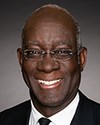As he has said, it's public already, so you can have it.
For five minutes, I would like to invite Mr. Wilson Miao for more questions.
Go ahead.
Evidence of meeting #33 for Veterans Affairs in the 44th Parliament, 1st Session. (The original version is on Parliament’s site, as are the minutes.) The winning word was employment.
A recording is available from Parliament.
4:15 p.m.
Liberal

The Chair Liberal Emmanuel Dubourg
As he has said, it's public already, so you can have it.
For five minutes, I would like to invite Mr. Wilson Miao for more questions.
Go ahead.
January 30th, 2023 / 4:15 p.m.
Liberal

Wilson Miao Liberal Richmond Centre, BC
Thank you, Mr. Chair.
Welcome back to the committee.
I understand that last November, in fact, our minister hosted a veteran employment consultation here in Ottawa. What are the biggest take-aways or what have you been hearing from the round table? More specifically, what are some of the comments you heard from the participants?
4:15 p.m.
LCol (Ret'd) Chris Hutt
Thank you, Mr. Chair.
I was part of that consultation process. It was a very robust discussion involving a number of employers and third party organizations that I've mentioned and that we've been talking to.
Some of the key take-aways were with regard to the communication. Call it the ability of veterans to communicate what they are bringing to the table or the value proposition of their skills and experience, and the employers' ability to understand what that value proposition is. The need was to provide tools for both sides of that equation to understand the skills and experience that veterans have and to be able to communicate that.
In the comments we saw, another one was really on the supports for employers. It's not just about recruiting veterans and getting them in the door. It's about retaining the veteran workforce. It's about creating an environment where veterans are part of the workforce, are integrated and have mentors and a network of practice or a community of practice that supports veterans in the workplace.
The third key take-away was that there really isn't a silver bullet solution. It's going to be a system or a suite of solutions that we have to bring to bear and to provide to meet the needs of both the veterans and the employers interested in operating in this area.
4:15 p.m.
Liberal

Wilson Miao Liberal Richmond Centre, BC
Thanks for sharing.
I understand that Mr. Harris's earlier remark mentioned the outreach for the veteran employment strategy, including through social media and also LinkedIn. Is there any other avenue to reach out to employers and even participants across the nation to better allow them to understand what is available and the communications piece?
4:20 p.m.
LCol (Ret'd) Chris Hutt
It was mentioned that we have the veterans employment unit within Veterans Affairs Canada, and they have an existing network of employers that are actively engaged with them, involved in discussions and participate in our social media, including the “Hire a Veteran” LinkedIn group. They also maintain a dialogue and talk about how they can promote that community practice.
It's an ever-growing network that is actively maintained by our veterans employment unit. In a day long gone, I would have referred to it as the “rolodex”, but it exists still. It's the same as that network of veterans that reach out to the veterans employment unit looking to network and to establish that network. Really, as part of the employment strategy, it's something that we need to grow because it's a very small nucleus within the employment unit.
How do we create a veterans network and a veterans employer network that becomes its own entity and lives and generates on its own?
4:20 p.m.
Liberal

Wilson Miao Liberal Richmond Centre, BC
Is there a challenge in reaching out to some of the veterans who don't use this kind of technology in order to help them with the transitional process?
4:20 p.m.
LCol (Ret'd) Chris Hutt
Thank you, Mr. Chair.
Yes. We try to use as many channels as possible.
For instance, as someone is going through the transition process, it's not just an electronic or digital process. There's an actual physical series of touch points with the veteran, both while they're serving and immediately after they are serving, where they go through interviews within the CAF and with VAC that provide and align them with the services and supports they need, including those career transition supports. They're physically told.
There are also some educational products that cover transition in general, but specifically targeting those employment aspects of it as well. There are online learning products and some actual lectures they go through while they are serving and have access to while they are not serving. Then there are some communications products: actual releases and things of that nature. There are multiple channels through which we try to make sure the message gets out as broadly as possible.
4:20 p.m.
Liberal

Wilson Miao Liberal Richmond Centre, BC
Thank you.
For some of the veterans who would like to find work in the public service, how is the department helping the veteran with that? Are there any barriers that they will encounter in getting work in the public service?
4:20 p.m.
LCol (Ret'd) Chris Hutt
One of the findings that we found through the consultations is that there are some challenges with getting into it. I wouldn't say there are barriers, but there are challenges and friction to getting into the public service. One of them is the complexity of the application process. Another is the duration of the application process. It's one of those that if you're transitioning out of the military, a long application process to get into the public service isn't necessarily what you're looking for. Those are some of the challenges.
Some of the work that we're doing is.... We are actively partnered with the Public Service Commission, DND and the Canadian Armed Forces, working on ways to better implement the provisions that were made within the Veterans Hiring Act, and to operationalize and smooth out some of those friction areas and challenges within the hiring processes that are done across the public service. That will be integral to the national veterans employment strategy as well.
4:20 p.m.
Liberal

The Chair Liberal Emmanuel Dubourg
Thank you so much.
Thank you, Mr. Miao.
I now turn the floor over to Mr. Desilets for a quick two and a half minutes.
4:20 p.m.
Bloc

Luc Desilets Bloc Rivière-des-Mille-Îles, QC
Thank you, Mr. Chair.
Mr. Harris, when do you expect to have the strategy you mentioned earlier completed and in place?
4:20 p.m.
Assistant Deputy Minister, Service Delivery Branch, Department of Veterans Affairs
It will be in the near future—probably a few months from now.
4:20 p.m.
Bloc

Luc Desilets Bloc Rivière-des-Mille-Îles, QC
You stated earlier that priority should be given to hiring veterans when resources are available. That is what I understood.
In your opinion, is a healthy transition from the military to civilian life a question of money and means?
4:20 p.m.
Assistant Deputy Minister, Service Delivery Branch, Department of Veterans Affairs
I don't think it's a question of money or means. It's a question of communication. You have to know where to find the resources to have support measures that help veterans make the transition they seek. Sometimes, it is a transition towards retirement; sometimes, it is towards part‑time or full‑time work in a promising area, such as entrepreneurship.
4:20 p.m.
Bloc

Luc Desilets Bloc Rivière-des-Mille-Îles, QC
You have the financial resources that you need to carry out this strategy. Is that correct?
4:20 p.m.
Assistant Deputy Minister, Service Delivery Branch, Department of Veterans Affairs
Yes, we work closely with veterans in order to support them.
4:20 p.m.
Bloc

Luc Desilets Bloc Rivière-des-Mille-Îles, QC
You are telling me that you have enough funding to carry out the project.
4:20 p.m.
Assistant Deputy Minister, Service Delivery Branch, Department of Veterans Affairs
Yes.
4:25 p.m.
Bloc

Luc Desilets Bloc Rivière-des-Mille-Îles, QC
I'm happy to hear that.
This morning, there were reports in the newspapers indicating that close to $1 billion from the 2021‑22 budget had not been spent. That is a pretty big chunk of cash. More precisely, there were $921 million in unspent funds.
I'm trying to establish the link with support services for veterans, for which $12 million has yet to be spent.
How can this be?
4:25 p.m.
Assistant Deputy Minister, Service Delivery Branch, Department of Veterans Affairs
I'm not sure I heard the last point that you raised. You are talking about $12 million?
4:25 p.m.
Bloc

Luc Desilets Bloc Rivière-des-Mille-Îles, QC
In the funding envelope for support services for veterans alone, $12.7 million has not been spent during the financial year. In total, $921 million remains unspent. I don't understand.
4:25 p.m.
Assistant Deputy Minister, Service Delivery Branch, Department of Veterans Affairs
I am not the Department of Veterans Affairs' financial expert. However, I can tell you that we have spoken a lot before the committee of the fact that we have funding envelopes for each program within the department. We always ask for more than the amount that we would spend, so as to avoid being in a situation where we don't have enough funds.
4:25 p.m.
Bloc

Luc Desilets Bloc Rivière-des-Mille-Îles, QC
If you don't have enough funds, request budget transfers. You have $921 million that hasn't been spent.
4:25 p.m.
Assistant Deputy Minister, Service Delivery Branch, Department of Veterans Affairs
The money remains within the department. It is always there in case we need it.
4:25 p.m.
Bloc

Luc Desilets Bloc Rivière-des-Mille-Îles, QC
I understand, but it is expected that that money will be spent during the financial year. The remaining funds will be rolled over to the following financial year, but there won't be any increase. More requests will be made, but there will be no increase. That is not the way that budgets are usually managed. I'm not criticizing you personally, but you have funds that are just sitting there doing nothing. That's approximately 15% of your budget.